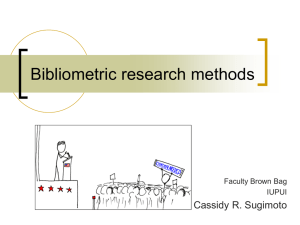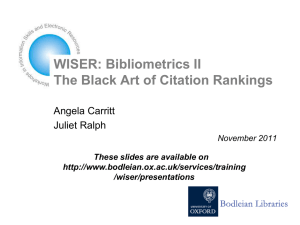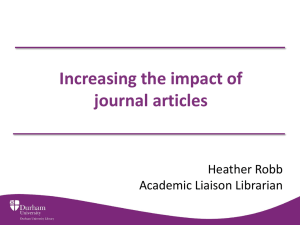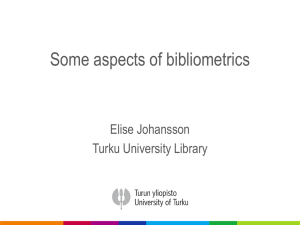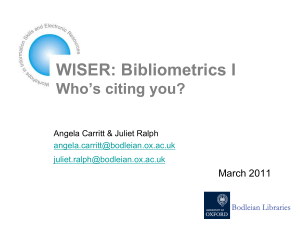Presentation - Bodleian Libraries
advertisement
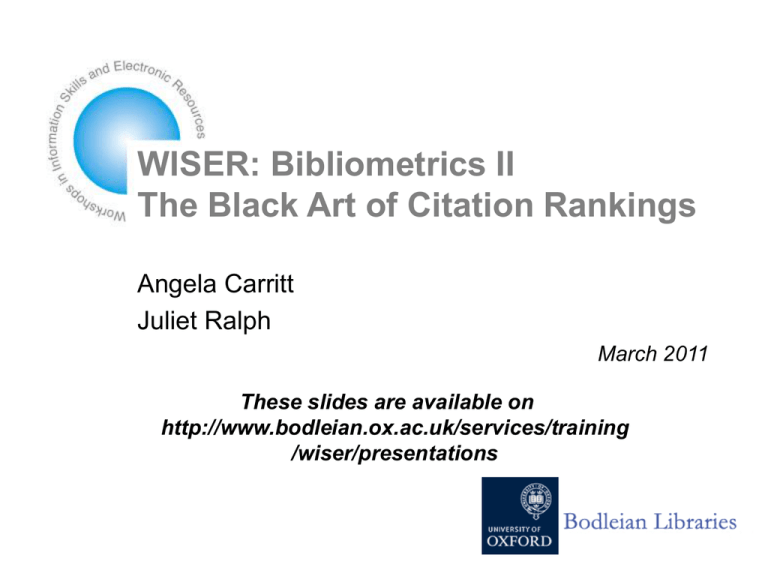
WISER: Bibliometrics II The Black Art of Citation Rankings Angela Carritt Juliet Ralph March 2011 These slides are available on http://www.bodleian.ox.ac.uk/services/training /wiser/presentations Overview of Session • What are bibliometrics? • Why bother? • Problems • Calculating impact factors using Web of Science • • • …for an article …for a researcher …for a department / institution • Calculating impact factors using Scopus • Calculating journal impact factors using the Journal Citation Reports What are bibliometrics? •…the statistical analysis of books, articles, or other publications. Oxford English Dictionary •…”ways of measuring patterns of authorship, publication and the use of literature” HEFCE, Bibliometrics and the Research Excellence Framework (REF) • Use of citation information to measure the impact of research Citations to an individual paper 2010 2010 2010 2009 2008 2008 Citations to a researcher Citations to a research group/department Citations to a journal Continued…. • Wide range of formulae developed which aim to use citation information to assess research impact accurately • Some of the things that are sometimes considered… • • • • • • Number of articles published Number of self citations Type of article Period over which articles were published Prestige of citing journal Subject/discipline… The power behind Why bother?... REF • “The pilot exercise showed that citation information is not sufficiently robust to be used formulaically or as a primary indicator of quality; but there is considerable scope for it to inform and enhance the process of expert review” HEFCE www.hefce.ac.uk/research/ref/Biblio/ • Research Excellence Framework 2014 • • • quality of research outputs (65% weighting 2014) wider impact of research – (20% weighting in 2014) - measured by case studies vitality of the research environment 15% weighting in 2014) • Expert panels decide whether or not to use citation information under the “quality of research outputs” heading • Panels to annouce their “criteria statements” in late 2011 - watch this space HEFCE, REF and citation information • Central guidance to ensure that departments are not disadvantaged by missing data • Information will be standardized, simplified…and made available to universities for a small fee • HEFCE will assess the (financial) cost of using citation information • More @ http://www.hefce.ac.uk/research/ref/Biblio/ Why bother • Benchmarking of departments and research groups • Grant applications • Recruitment of individuals Lots of problems... • Self-citations • Negative citations • Insignificant citations • Multiple authors/research groups • Incomplete citation lists - does not include citations in books... or other publications not indexed by Web of Science/Scopus…poor coverage of conferences • Not comparable across disciplines – may disadvantage researchers in interdisciplinary fields • Review articles are more highly cited than original research • More... http://www.slideshare.net/guest633b30/bibliometrics-and-scientometrics-1065282 © http://ceochef.files.wordpress.com/2008/07/pinch-of-salt.jpg Individual articles • On Web of Science - use Cited Reference Search • Better than General Search at retrieving Variants (incorrect citations). • Example: • Effectiveness of PowerPoint presentations in lectures. Author(s): Bartsch RA, Cobern KM • Source: COMPUTERS & EDUCATION • Volume: 41 Issue: 1 Pages: 77-86 • Published: AUG 2003. Cited reference variant Analyzing a highly cited article Analyzing the Citing articles …by highest citing Authors …by highest citing Journals or create a Citation Map Citation map Impact factors for a researcher Citation report for an author h-index=75 75 articles cited 75 times or more Citation tracking & analysis in SCOPUS • Scopus covers 18,000 journals in Science, Mecicine, Social Sciences & Humanities • Results include journal articles & conference proceedings • Each record for a paper shows the number of times it has been cited in Scopus since 1996 • Similar analytical tools to Web of Science • www.scopus.com Citation analysis in Scopus h-index = 73 based on citations in Scopus post-1996 to 537 papers h-index = 63 if exclude self-citations …for a department or institution • Not always easy! • Web of Science - Search the Address field • Must use standard abbreviations, e.g: • oxford univ • But word order makes a difference! • univ oxford retrieves thousands more results • more researchers use University of Oxford - not Oxford University - in their address • Can also search by postcode, e.g. • OX1 2JD (Wellington Square) Searching by Address Check the abbreviations lists Searching by department or college • • • • • Postcode or name Tip: include univ oxford same or oxford same in search string to weed out other institutions, e.g. univ oxford same pathol oxford same trinity oxford same Ludwig Inst Canc Res Scopus has Affiliation Search • • Search by institution name not postcode university of oxford retrieves same results as oxford university Scopus Affiliation Search Scopus Affiliation ID Symplectic Elements Symplectic Elements • record keeping tool for research outputs • automatic searching of databases such as Web of Science & Scopus • Facility to run reports for a department • For more information go to • www.admin.ox.ac.uk/pras/research/symplectic/ • The solution for your department? • Contact symplectic@admin.ox.ac.uk Impact Factors - Journal Citation Reports (JCR) • Compare relative importance of journals using citation information • Based on citation data from Web of Science • Covers • > 5,900 journals in science and technology • > 1,700 journals in the social sciences Uses & Abuses • Uses • • Help you to decide where to publish Help librarians to make decisions about journal purchase etc • Abuses • Have been used to measure research impact of individual and research groups Immediacy Index Measures how quickly articles are cited. Calculated: no. of citations to articles published this year ÷ no. of articles published this year. Impact Factor - Number of times the “average” article published in the previous 2 (or 5) years was cited this year. Calculated: no. of citations to articles published in the last 2 (or 5) years ÷ no. of articles published in same period. Cited Half-Life - How many years you have to go back to account for 50% of citations to the journal. e.g. 50% of citations were to articles published in the last 3.5 years. The rest cited earlier articles. Detailed view Detailed view continued Detailed view continued Citations TO the journal by year of cited article (e.g. 333 of this year’s citations to Biological Review were to articles published in in 2005 ) Detailed view continued Citations from Biological Review (to other journals and self cites) by year of cited article E.g. 334 citations from Biological Reviews journal cited articles published in 2007 Type of articles included Eigenfactor Metrics • Take into account prestige of citing sources • Use “Google style” algorithms • Attempts to measure how often the average researcher would encounter the journal • http://wellformed.eigenfactor.org/ Google’s PageRank from http://en.wikipedia.org/wiki/PageRank Eigenfactor: Score & Article Influence • Eigenfactor – increases with the size of the journal • Article Influence – Takes into account number of articles published. More comparable to the JCR impact factor Journal Impact Factors: Problems Use with caution…Results are skewed by many factors… • Size • Frequency / time of publication • Type of content - review articles are more heavily cited than original research… • Journals that are not indexed by WOS are disadvantaged • Non English Language journals disadvantaged • “Cited” only journals • Problems when journals change names • Results are not comparable across discipline (some journals in the wrong discipline) • Journal impact factors should NEVER be used to assess impact of researchers / groups etc Brief bibliography General • Broadus, R. N., “Towards a definition of Bibliometrics” Scientometrics, vol. 12, nos 5-6, (1987) 373-379 @ www.springerlink.com/content/v111750n14086384/fulltext.pdf • HEFCE papers, reports, papers and pilots on the use of bibliometrics in the REF @ www.hefce.ac.uk/research/ref/Biblio/ H-Index • Hirsch, J. E. (15 November 2005). "An index to quantify an individual's scientific research output". PNAS 102 (46): 16569–16572 @ www.pnas.org/content/102/46/16569.abstract • Ball, P. “Index aims for fair ranking of scientists”, Nature 2005 Aug 18 436: 900 Brief bibliography Journal Impact Factors and the JCR • The Thomson Reuters Impact Factor (originally published in the Current Contents print editions June 20, 1994) @ http://thomsonreuters.com/products_services/science/free/essays/impact_factor/ • Garfield, E. "The agony and the ecstasy: the history and meaning of the Journal Impact Factor“ Paper at the International Congress on Peer Review And Biomedical Publication, Chicago, September 16, 2005 @ http://garfield.library.upenn.edu/papers/jifchicago2005.pdf Want more… • Wikipedia entries on the following topics include useful bibliographies: the h-index, journal impact factors and the Eigenfactor • A Google Scholar (http://scholar.google.co.uk/) search will return many useful articles including subject studies on the use of bibliometrics
